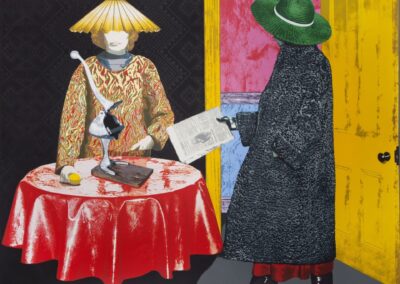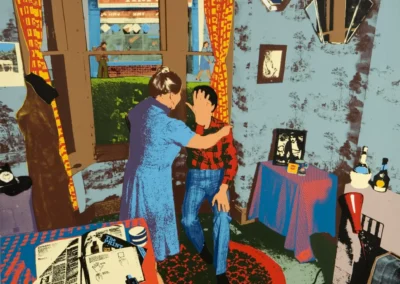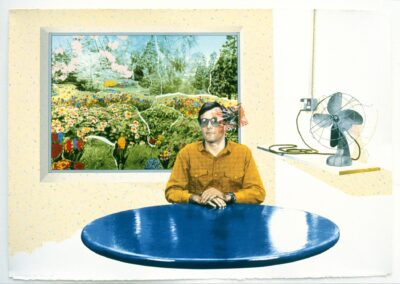Our next Artist You Need To Know is Tim Mara (1948 – 1997).
Mara was an Irish printmaker whose practice embraced digital printing techniques in tandem with more traditional methods, employing a printing press as often as he used inkjet printers, scanners and computer technology. He was a professor of printmaking at the Royal College of Art in London until his unexpected and far too early passing. Considered a master in terms of technique, Mara was less interested in demonstrating this facility than in storytelling in his choice of subject matter : “In the hierarchy of fine art, printmaking is usually associated with craft skills – with technique. And that gets in the way. My work was always about the ideas more than the medium.” (from here)
“Print-making and his relationship with it carried a kind of post-pop socialism perfectly reflected by teaching. His own images, juxtapositions of vivid colour and strange displaced objects, portraits and interiors were ambitious and exciting….These large multi-layered works constructed a complex and challenging set of questions, dense and intriguing. He moved the subject on.
He was an academic, but also an artist…There is a good deal of craft to making prints and his knowledge was generous and broad, but when it needed to be, specialist and profound.” (from the Irish Times)
Born in Dublin, his family relocated to London in 1955 : Mara attended the Epsom and Ewell School of Art (1968-70), Wolverhampton Polytechnic (1970-73) and the Royal College of Art (1976). Mara’s first solo exhibition took place at Birmingham Arts Lab (1974) and he would exhibit consistently with Flowers East Gallery from 1988 onwards. He also founded the Wildman Corner Studio in 1989; as mentioned previously, Mara would go on to be a Professor of Printmaking but also the Head of the School of Fine Art at the RCA. “Widely regarded as an outstanding technician, Mara exhibited in over 80 group shows in the UK [beginning in 1974], and in more than 50 international exhibitions, including a solo show at IMMA [Irish Museum of Modern Art] in 2000. Mara’s work is in public and private collections worldwide.” (From Áras Nua-Ealaíne na hÉireann | The Irish Museum of Modern Art)
A more detailed listing of his solo and group exhibitions (and the many collections that have his work) can be seen here.
Tim Mara’s “work has been likened to the pop-art movements of the 1970s, although the artist saw his work more in terms of “old masters in modern dress.” He adopted features of the Dutch Masters, such as light, clarity and stillness, while exploring other themes such as repeating patterns, reflection, refraction and shadow. Mara looked at familiar objects in familiar ways, without iconising them; many everyday objects are printed and juxtaposed in his prints, driving this point home, but also exploring other topical issues, such as the miner’s strikes, morphic resonance, symbolism and identity.” (from the Flowers Gallery)
Mara’s practice was focused nearly entirely on printmaking, rarely branching into other media. His expertise was recognized in that he was commissioned in write the Thames and Hudson Manual of Screen Printing. But as previously mentioned, he was not a printmaker who eschewed technological advances in his field : he explored photographic screen printing (a months long, labour – intensive medium) as well as more ‘standard’ intaglio techniques, building on the work of those who’d come before him and expanding this field with groundbreaking techniques. In later decades of his career, colour separation photolithography – often in tandem with screen printing – were hallmarks of his artmaking.
From TATE : “Technically his prints are very dense and complex, often with as many as fifty or sixty separately printed colours. He did not wish to be thought of as a Pop artist [as his images offer more nuance and consideration of history, both personal and more public, than that genre usually does] and said that his heroes were the painters Piero della Francesca, Velásquez and Vermeer.”
Mara earned a number of awards during his career. These include recognition at the 11th Norwegian Print Triennale (Fredrikstad, 1995): the British International Print Biennale (1982 and 1984): the Greater London Arts Association Award (1978): a travelling scholarship from the Royal College of Art (1976): the New Contemporaries Award (1975): and Mara was the Stowells Trophy Winner in 1972.
From Mara’s obituary in The Irish Times :
“In art education and, in particular, postgraduate Fine Art, Tim was special and unique, a substantial marker and cornerstone to the subject. He was hard-working, scrupulous, very much part of the team and the institution, but also there for the students and the subject itself. This difficult three-handed relationship he managed with his generous spirit and good nature, demanding but easy, direct but open, with experience and youth on his side. The rigour with which he operated an egalitarian position set the highest standards that marks his stature and standing as an academic and as a person. A truly decent man, he expected and sought a respect of the individual and subject without any prejudice for style or fashion, only the pursuit of excellence. He gathered to him an energy and optimism, a down-to-earth humanitas, unruffled and real, truly reasonable.”
Tim Mara passed in 1997. The Scottish Herald offered the following : “Tim Mara’s shocking sudden death from a heart attack at the age of 48 has cut a career in its prime and robbed the printmaking world of one of its major figures.” A number of tributes described him as the leading printmaker of his generation.
An insightful talk with Mara’s daughters Alice and Emily can be seen here.



























